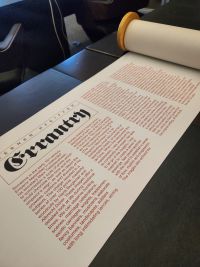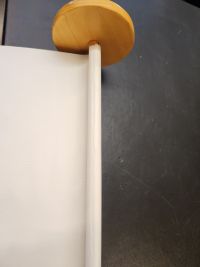Beyond Pedagogy and Aesthetics: Werner Pfeiffer's ''Errantry''
Errantry is an artist book created by Werner Pfeiffer. The book was published in 2008 by Pear Whistle Press located in Red Hook, New York. This copy is the twelfth in a series of 52 signed and numbered copies.

Overview
Errantry is housed in the Kislak Center for Special Collections, Rare Books and Manuscripts located on the fifth and sixth floors of the University of Pennsylvania's Van Pelt-Dietrich Library. The library directly purchased this copy from Pfeiffer. This book challenges the traditional expectations of a book and measures up to the liminality between publications and art. Pfeiffer's work, and that of other artists, add to the debate concerned about the purpose and point of artist books.
Defining Artist Books
There is a constant debate about whether artists' books qualify more as art or as books. Jo Milne, an artist and researcher argues that artist books are "hybrids resistant to definition."[1] Artist books, at times, do not even look like the typical codex. Regardless of this, they are charged with meaning and possibility. Interacting with an artist's book tends to be a sensorial mission guided by carefully chosen materiality.
There are many different formats for the artist's book. As mentioned before, not all of them resemble the codex. In fact, there are foldable books, scrolls, series of objects in unison with text, and visual art alongside writing. Because there are many different ways to handle an artist's book depending on the format and approach, the stories (if any) are not always linear. In the case of Errantry, the artist's book is a scroll. Because the navigation style a scroll invites is linear, the materiality of this particular book lends itself to a linear narrative. The visual elements of the project and the intentions behind it add to the discourse in defining artists' books. The materiality and intention of Errantry will be discussed further in another section.
In curating exhibits of Pfeiffer's work, two professors discussed the purpose of Pfeiffer's work and the necessity to highlight the interactivity of textual and visual formats. However, they also had a hard time defining the hybrid in question. Andrea Wollensak, an art professor and curator, explains, "Artists' books are books that have been created by artists that explore and experiment and test the definition of what 'book' is...and a lot of them are not books at all." [2]
Werner Pfeiffer as Artist and Author
Pfeiffer emigrated from Southern Germany to Brooklyn, New York in 1961. Soon after, Pfeiffer became an art professor at the Pratt Institute of Brooklyn. Additionally, he became the director of the Pratt Adlib Press, an in-house press at the institute. Pfeiffer's work is political in nature. After several years, Pfeiffer retired from teaching in 2002 to dedicate his time to his own art and his printing press, Pear Whistle Press. His work has been housed and exhibited at many places including, but not limited to, the University of Pennsylvania, Massachusetts Institute of Technology, Princeton, Cornell, and the Shain Library.
As an artist, Pfeiffer has been influenced by other intellectual, artistic, and literary pieces. Furthermore, his own life experiences permeate his work. For example, Pfeiffer's Liber Mobile was inspired by the philosopher Marshall McLuhan. Errantry, on the other hand, was inspired by J.R.R. Tolkien's poem Errantry and the woodcut series Triumps of Maximillian, a project commissioned by Roman Emperor Maximilian I.
Many of Pfeiffer's pieces have an underlying political message. This being said, he creates works that one can physically manipulate through their materiality. This materiality allows the reader to be a "co-producer of meaning" with the artist's book. [3]
'Errantry' Collection
This collection has a total of 52 units. The copy at the University of Pennsylvania is the 12th of the series. Several other places have copies of Errantry. Some of the places that also have copies are Princeton, Pratt, MIT, and the Toledo Museum of Art. Each of the units in the collection is similar in making. For example, each of the scrolls is made the same way, housed in an artillery casing, and placed within a hinge chest box.
Collection's Inspiration
The entirety of the collection was inspired by Kaiser Maximilian's Triumpfzug (English: The Triumphal Procession of Emperor Maximilian). The title of the collections and individual pieces is both the same, and it echoes J.R.R. Tolkien's poem "Errantry" originally written in the early 1930s and published in the 1960s. The illustrations and poems tell an overarching narrative of the increased violence and conflict of the 20th century at the hands of technological advancement. Below the illustrations and poem, which are visually interwoven, one can perceive a vertical timeline populated with the names and casualties of violent wars and genocides. This timeline is based on Piero Scaruffi's Wars and Genocides of the 20th Century which is now titled Wars and Casualties of the 20th and 21st Centuries due to constant updating. 
Content Interpretation
The entirety of the collection is loaded with political meaning that can be interpreted differently depending on who is interacting with the pieces. As already mentioned, the scroll is housed inside a 105 mm 1945 artillery casing from R. C. & B. Incorporated. This company is presumably inactive as no other information, current or otherwise, can be found about it. By compiling and formulating a timeline with the information of 20th-century wars and conflicts and placing it inside one of the weapons used to deliver said violence, Pfeiffer constructs his own bomb. However, this bomb is one of information and artistry intended to show the precarious path humanity has been in. Instead of simply leaving the timeline, poem, and illustrations to tell an independent story, Pfeiffer provides the audience with an explanation behind his inspiration and intentions that allows for direct insight into his positionality in each of these conflicts.
Like many of his other's projects, Pfeiffer's Errantry provides ample political and social commentary about the status quo. In this case, the rapid industrialization and expansion of military power and technology led to one of the deadliest centuries. The poem offers a narrative of a power-hungry, blood-seeking machine without consideration for that in the way. The illustrations show abstract war machines covered in spears, projectiles, and more. The ever-changing illustrations ad to the poem's meter and syntax increasing the feeling of terror that surrounds war. With the materiality and format of the scroll, the reader can follow the rampant machine while simultaneously learning about the deaths at the hands of similar, and real, machines.
'Errantry' Form and Structure
This artist's book has three main components to its visual composition. These are the holding chest, the artillery casing, and the scroll.

Holding Chest
The chest is structured like other chests. However, there are a few key characteristics of functionality. The chest's hinges allow it to open fully to the point where the lid can touch the surface the chest is opened on. There are two hook latch contraptions on the top half of the chest intended to hold onto the screws on the bottom half to keep the chest closed. The chest has a built-in structure intended to hold the casing in place for transportation. The holding structure is made of wood and lined with a protective fabric similar to felt. The sides of the chest are equipped with handles. On the inside of the top portion of the chest, Pfeiffer placed an informational plaque explaining that the chest's dimensions changed accordingly with the casing being used. The plaque also goes into more detail about the casing being used as each one is unique to the scroll it houses.
Artillery Casing
The casing used in the twelfth copy of Errantry is a 105 mm Howitzer artillery shell. This casing has several identifying inscriptions at its base. According to the base stamp, this casing was manufactured in 1945 by R. C. & B. Inc. as part of lot R.C.B 160. Below the year and manufacturer information, there is a small stamp that resembles a flame above a circle. These identifiers could be different in each copy of Errantry since different casings were used for each. Each of the casings was active at some point and actually delivered a blow during a conflict. This type of artillery was used during World War II and is still in active use. [4]
Scroll
The scroll is composed of a wooden dowel that has a fixed circular end at the bottom and a removable one at the top. The ability to remove the top circular stopper allows for an easier process when re-rolling the entire scroll. Both ends of the dowel differ in length. Because the scroll is inserted vertically in the artillery casing, the top dowel piece is longer for easier grip. This makes it possible to securely hold on to the scroll to pull it out of the casing. The shorter half of the dowel has a complementary wooden block at the bottom of the casing to accommodate it when stored while also keeping it in place. The "paper" on the scroll is a long piece of canvas fabric attached to the wooden dowel by a strong adhesive and then secured with a type of tape similar to masking tape. The tape on the scroll is stronger than typical masking tape while still providing flexibility for the rolling and unrolling of interacting with the project. The text on the scroll is digitally printed in either black or red with both Arial and Fette Fraktur fonts.
For protection and ease, Pfeiffer made a tube the exact size of the rolled-up scroll that is meant to encase the canvas and prevent it from unrolling.
References
- ↑ Milne, Jo. "Artists’ Books as Resistant Transmitters." Arts, vol. 8, no. 4, 2019, pp. 129. ProQuest, https://proxy.library.upenn.edu/login?url=https://www.proquest.com/scholarly-journals/artists-books-as-resistant-transmitters/docview/2546881581/se-2, doi:https://doi.org/10.3390/arts8040129.
- ↑ Angele-Kuehn, Sophia. "The Medium is the Message - Literally - in Werner Pfeiffer's Typography and Artist's Books." UWIRE Text, 4 Mar. 2019, p. 1. Gale OneFile: News, link.gale.com/apps/doc/A576943211/STND?u=upenn_main&sid=summon&xid=1c1245d8. Accessed 3 May 2023.
- ↑ https://www.mdpi.com/2076-0752/9/1/32
- ↑ https://en.wikipedia.org/wiki/M101_howitzer


